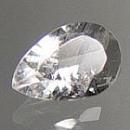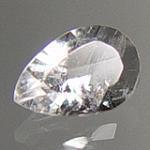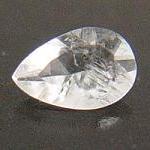|
|
|
|
Click on a letter above to view the list of gems. |
|
|
|
|
|
Cryolite |
|
| Chemistry: Na3AlF6 [Sodium Aluminum Fluoride] | |
| Discovered
in 1799;
IMA
status: Valid (pre-IMA; Grandfathered). | ||
|
| ||
|
Classification |
|
|
| |
|
Halides | |
|
3/B.03-30 | |
|
|
3 : HALIDES |
|
Related to: |
Kryolithionite-Calcjarlite Series |
|
|
|
|
Crystal Data |
|
|
|
|
|
Crystals are pseudocubic or short prismatic, striated, to 3 cm; also typically massive or coarsely granular. |
|
|
Common, according to one or more of 13 distinct twin laws, producing penetration, repeated, or polysynthetic twins. |
|
|
|
|
|
Physical Properties |
|
|
|
|
|
None; Parting on [001] and [110] |
|
|
Irregular, Uneven |
|
|
Brittle |
|
|
2.5 - 3.0 |
|
|
2.95 - 3.00 (g/cm3) |
|
|
Weakly thermoluminescent; may fluoresce intense yellow under SW UV, with yellow phosphorescence, pale yellow fluorescence under LW UV. |
|
|
Not Radioactive |
|
|
Other: |
Slightly soluble in water |
|
|
|
|
Optical Properties |
|
|
|
|
|
Colorless, Gray, White, Reddish brown, Brownish black |
|
|
Transparent to Translucent |
|
|
Vitreous, Greasy, Pearly |
|
|
1.3385 - 1.340 Biaxial ( + ) |
|
|
0.0010 - 0.0011 |
|
|
None; r < v |
|
|
X = colorless; Y = colorless; Z = colorless |
|
|
|
|
|
Occurances |
|
|
|
|
|
Geological Setting: |
A late-stage mineral in some granite pegmatites; in tin-bearing alkalic granites; a vapor-phase mineral along fractures and in the groundmass of some fluorine-rich, topaz-bearing rhyolites; in pods in a carbonatite vein cutting fenitized biotite gneiss. Also as a rare authigenic component of the marlstones and shales of the Green River Formation. |
|
Common Associations: |
Chiolite, Feldspar Group, Fluorite, Pachnolite, Quartz, Topaz |
|
Type Locality: |
Cryolite deposit, Ivittuut (Ivigtut), Arsuk Firth, Arsuk, Kitaa Province (West Greenland), Greenland |
|
Year Discovered: |
1799 |
|
View mineral photos: | |
|
|
|
|
More Information |
|
|
|
|
|
| |
|
|
|
|
Sources of Cryolite include the Ivigtut area of Greenland and also at the foot of Pikes Peak at Creede, Colorado, USA, Mont Saint-Hilaire and Francon Quarry, Montreal, Quebec, Canada and at Miask, Russia. Gem quality crystals are usually only from Francon Quarry.
|
|
|
|||||||||||||||||||||||||||


